REBECCA RENNIE BIG BOARD 2022: SMALL SCHOOL TOP 75
By Rebecca Rennie
The NFL Draft talent to be found at small schools from the FCS and beyond is strong every year, and 2022 is no different. This presents my Top 75 small school prospects for the 2022 NFL Draft. The project was challenging to put together this year, with time constraints and some life issues outside of football almost derailing any chance of completing this season’s big board. Thankfully, it was possible to pull this together in time for the event. It’s almost certain that there are plenty of names not included here that absolutely should be. Unfortunately, it was not possible to get to everyone’s film, so apologies if any personal favorites are missing!
Though expecting this to be more brief this year, ultimately we have around 23,000 words of content in this article over four pages. The Top 30 graded prospects have been written up in detail, 10 per page, with one bonus write up on an additional prospect, given he is a well known prospect and QB, but was not graded as highly here. The fourth page contains the full Top 75 big board as a list. Regardless of where they appear on this list, the belief is that all these players have the potential to be pros in the right situation, it’s a fantastic group.
For the Top 30, a number grade has been included out of 100 that I have been using for a number of years. It is not formed as a sum of various parts for various traits, more so relating to a projected role for the NFL as starters, backups, developmental prospects and so on. They can be roughly correlated to a general round of the draft which is also given for some context.
There is a lot of content within this project and would be surprised if many intend to read this start to finish. However, whether used pre-draft or after your team has picked up one or more of these players during or after the draft, I hope this provides some useful information or reference.
1. Trevor Penning, OT, Northern Iowa. Grade: 89 (1st-2nd Round)
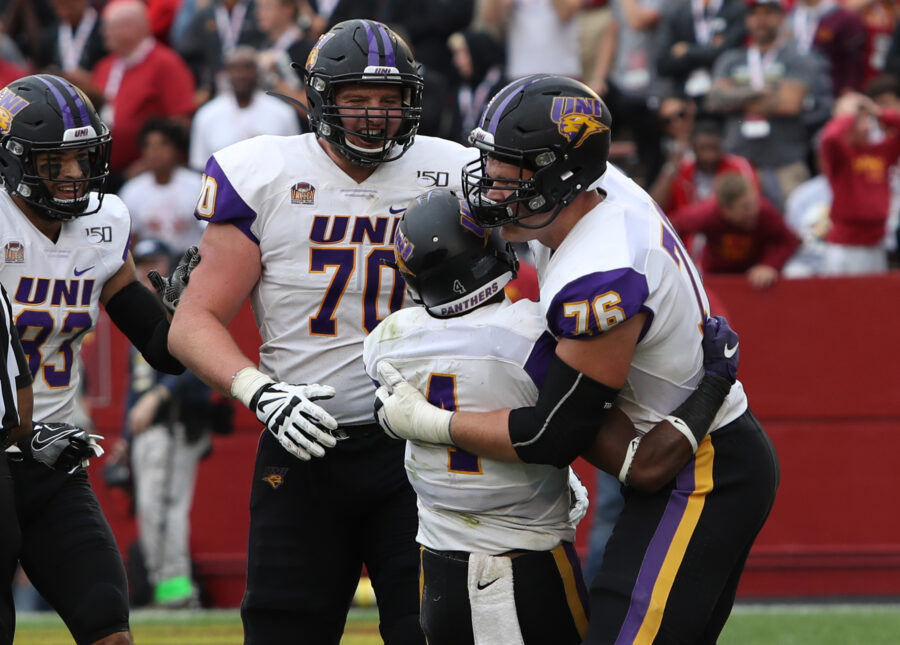
Height: 6’7”. Weight: 333lbs. Arms: 34” 3/4.
Pros: Much like last draft’s standout FCS prospect Trey Lance, there are question marks and concerns but plenty to validate the high draft projection. Widely discussed as a potential first rounder last summer, that has been maintained as a prevailing opinion into the latter stages of the pre-draft process, despite some inconsistent performances that have resulted in being one of the more debated prospects in the 2022 class.
The imposing frame and physical traits are an obvious starting point. Penning’s stature is close to ideal. The frame features outstanding size, length and well-distributed bulk. Combined with desired core strength, he provides a stout base. The build is paired with impressive foot quickness, agility and overall athleticism for his size. Penning’s Scouting Combine performance underscored the uncommon movement skills for his build that was apparent throughout his game film. His tied-2nd ranked dash of 4.89 (1.65 split) and fastest 3-cone (7.25) in Indy were complimented by 28 bench reps at his recent pro day.
The Panthers O-lineman has become somewhat famous, or infamous perhaps, for his aggressive and nasty demeanor. Reps during 1-on-1s at the Senior Bowl were heavily critiqued for both the positives and at times negatives of the play style. However, there’s no question that his mauling intensity provides a dominance at the point of attack that frequently stands out. His run blocking film consistently showcases the ability to drive defenders out of position. More than just physically owning the opposition, he frequently executes directional blocks to seal off defenders.
As a pass protector, the UNI tackle releases well from his stance for a big-bodied blocker. The hands often land an effective initial punch with generally good hand positioning. He has the quickness to establish depth in his pass sets and stride length in his kick slide to stay in phase with outside speed rushes. In tandem with the sheer size, bulk and length, he is difficult to both work around or work through when at his best. The footwork allows Penning to be capable of resetting and redirecting sufficiently as he changes direction and reacts to countermoves, just requiring doing so more consistently.
Cons: While Penning demonstrates effective technique at times, he can be frustratingly inconsistent in doing so. In pass protection, his early phase technique is generally superior to his latter phase technique. The release and first contact usually sets up his reps well, but can frustratingly fail to see it through. Too often, Penning can struggle to sustain blocks throughout and maintain control. Pass rushers at the FCS level have been able to find some success in disengaging from contact and leaving Penning struggling to recover.
There is also a tendency to resort to holding in such scenarios, even if they often go uncalled. Penning had a shaky performance against a North Dakota State front that was lacking its best rusher. In fairness, he appeared to be aware of that in the following performance against South Dakota. The redshirt senior lineman seemed to make a point of finishing every block and playing with a renewed edge, even more so than usual.
Film from previous seasons highlighted some concerns over his form and leverage that has shown some improvement. There are times though that he can still lower his head and lunge into contact and negate some power advantages through his pad level. Losing control can occasionally factor into run blocking in space with some missed opportunities when the target is not in his direct path line. Penalties have been a problem at times and might continue to be a part of his game going forward.
Wrapping Up: Penning gained some additional notoriety during an eventful Senior Bowl week that showcased many of the best aspects of his game, but also some of the areas that require work. The nastiness is primarily a positive though, as part of a high motor, physical style that works well with his ideal build. The Panthers standout has all the physical tools and traits to become a quality starting tackle in the NFL. He undoubtedly has work to do in order to fully reach that ceiling. All indications are that he has the desire to be great and love for the game that bodes well for his projection. There is appealing versatility to his deployment to potentially line up at both tackle and guard spots. Penning headlines an overall deep group of small school offensive linemen for the 2022 class.
2. Christian Watson, Wide Receiver, North Dakota State. Grade: 86 (2nd Round)
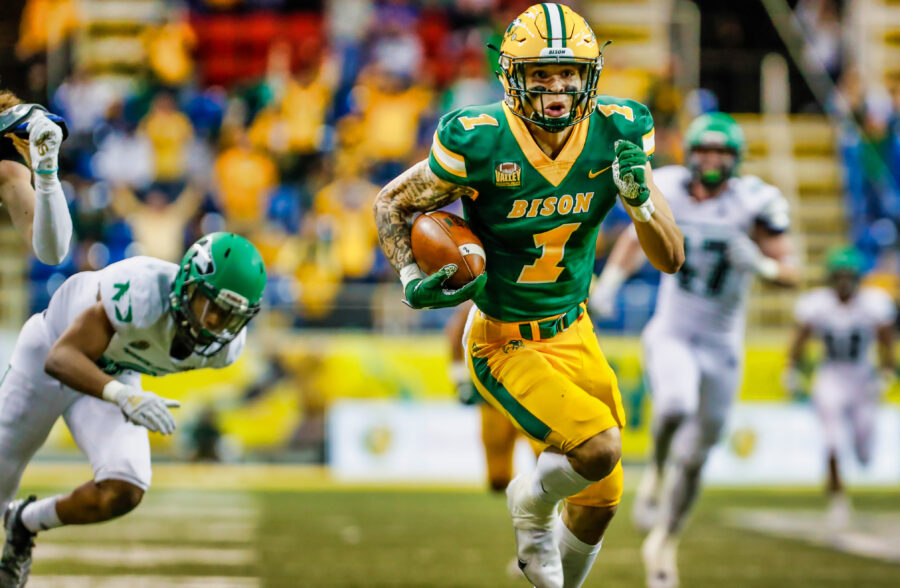
Height: 6’4”. Weight: 208 lbs. Arms: 32 1/2. Hands: 10 1/8.
Pros: All those previously scouting Trey Lance ought to be well aware of Christian Watson. The downfield target of many deep completions, the Bison receiver has been a spectacular big play highlight monster, dominating overmatched FCS corners. It does not take long though when watching his film specifically, to appreciate how more well-rounded his game is. His route running is a work-in-progress, but the skill set is absolutely there to contribute in a multitude of areas. Add in the rare explosive athleticism for his long frame, and Watson has a compliment of traits worthy of the early draft hype.
As listed above, Watson has length with impressive catch radius and big mitts to high point and catch outside his frame. He can look a little lean on film but weighed in at a sturdy 208lbs at the Combine. Watson was one of the standout stars of the event in Indianapolis with his testing and performance. His numbers included a spectacular 4.36 (1.45 split) in the dash at his size. His jumps of 38.5” in the vertical and 11’4 in the broad were no less impressive.
That explosion and long speed as he opens his stride are clear throughout his film. Even taking into account the relative competition level, the dynamic speed was evident. A large proportion of his deep targets were uncontested as Watson blazed past secondary coverage to separate with ease. Quarterback play was a little spotty for the Bison in 2021, at least in the early half of the season. Despite that, Watson averaged 18.6 per catch with 801 yards and 7 TDs on 43 receptions. With Lance in 2019, Watson was averaging 21.5 yards per catch.
More than just a deep threat, the NDSU receiver has potential to be highly versatile in his usage and target depth. While long-limbed, he shows under-rated change of direction over short areas and in breaking his routes. Fluid and agile, Watson has impressive efficiency of footwork for his frame that will aid him on more intermediate routes. The Bison star separates well on comebacks, with his threat to fly downfield working against conservate DBs fearing the deep ball. With almost 50 career rushing attempts, Watson is exceptionally dangerous with the ball in his hands and running after the catch that will fit well with recent offensive trends in the pros.
Cons: There are not many holes to pick in Watson’s game. An argument can be made for a level of uncertainty regarding how his playmaking will hold up against better competition. His performances at NDSU saw few opponents who could challenge Watson. His technique and route running did not require him to be consistently precise in part due to how easily he could win through his athletic advantages.
It’s fair to comment that his route running can improve as one of the primary areas of his game that could use refinement. He looked encouragingly better in this area in 2021. Regardless, the team that drafts him ought to feel confident that there is a baseline deployment for Watson while he sharpens certain other areas. That said, as previously mentioned, he absolutely has the fundamental agility traits and footwork to be impactful is a variety of areas.
There are receivers who can show more ownership at the catch point than Watson. Handling tenacity in contested situations from physical DBs could test Watson at the next level. He has had his moments with the occasional concentration drop. He looked outstanding securing the ball at both the Senior Bowl and Combine however, so this shouldn’t be a major concern either.
Wrapping Up: While Trevor Penning is generally considered the top FCS prospect for the 2022 draft, if anyone wants to place Watson at the top of the list, they can certainly make that case. The 22-year old redshirt senior has a length and speed combination to match with any of the top names in this receiver class. His at times under-appreciated short-area movement and footwork round out the skillset that creates the potential to be a highly versatile dynamic threat, including with the ball in his hands early as a runner. The first round is a possibility but should be selected quickly on day 2 if he lasts to that point.
3. Troy Andersen, Linebacker, Montana State. Grade: 80 (2nd-3rd Round)
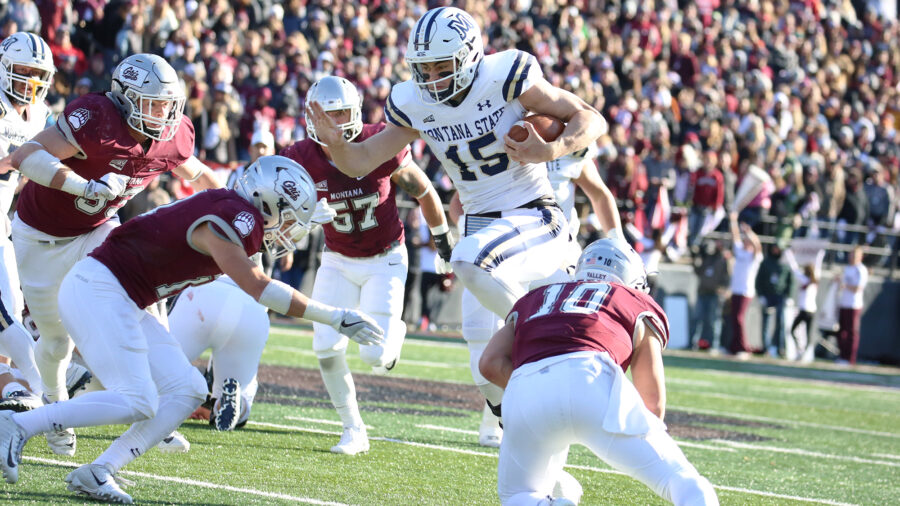
Height: 6’4”. Weight: 243 lbs. Arm: 32” 1/8.
Pros: There are few prospects in this class as fascinating as Troy Andersen. Beyond projecting a small school talent to the next level, the Bobcats linebacker has a less-than-conventional history and a very promising future. With outstanding athletic ability that few can match in 2022 regardless of position, he brings size, length, range and instincts that bely a relative inexperience in his primary positional role. There’s rawness yet exceptional upside. Playing for eventual FCS national runners up Montana State, his play and influence only grew through his standout season, culminating in a dominant playoff run that was emblematic of the team’s success.
Playing primarily offense in his early collegiate seasons, Andersen starting at running back and as a duel-threat quarterback. As the QB in 2018, the dynamic playmaker rushed for over 1,400 yards and 21 TDs on the ground. He saw significant time at linebacker in 2019 but continued to spend time on offense. It was not until this past year that Andersen was exclusively used at linebacker, excelling and ascending in the dedicated role. He piled up 147 tackles (83 solo), 14 TFLs, 2 sacks, 7 pass breakups and 2 interceptions.
Following the post-season run, Andersen has continued the upward momentum with standout showings at both the Senior Bowl and the Scouting Combine. The MSU defender showcased his explosiveness in practices at the All-Star event, including in space and coverage drills with fluidity in the open field, closing speed and timing to attack the ball. Combine testing confirmed the range evident on film. Andersen had a 4.42 dash (1.49 split), 36” vertical and 10’8 broad jump. He carries his 243 lbs well, with a toned physique to his long frame.
There are some processing and recognition improvements to make but Andersen’s instincts are typically good and undersold in some respects. Decisive and quick to trigger, he trusts his reads and closes quick. As his experience grows and his anticipation improves, his impact ought to only increase. The Bobcats defender gets easy depth backward and laterally with long strides to the sidelines and to win angles. His downhill burst was highly effective as a dangerous blitzer.
For a player still ascending at the position, the football IQ is apparent in his patience, timing and disguise. He can clean up the footwork and some false steps but there is control to his movement alongside active eyes that know where to look pre-snap. Working in the box and against the run, Andersen shows generally good technique as a wrap-up tackler, typically hitting ideal target zones of the ball carrier. He uses his nice length to aid in his takedowns. The motor and toughness shown throughout his game allows him to work into correct positions and finish most plays.
Cons: While the above included praise for Andersen’s instincts and overall football IQ, those broadly speak to how he applies himself and has allowed him to excel at multiple positions on both sides of the ball. There’s no doubt that there are flaws in the film and execution though. There is a decent amount of guessing pre-snap that can lead to false steps, wasted motion and delays in taking off toward the action. His athletic pluses can compensate at the FCS level but won’t so much in the pros. To his credit, those problems appeared to occur less frequently as the season progressed. He ought to continue to improve as he develops and with more time at the position.
The range and closing speed factor into the huge tackle production. There are times though that Andersen can struggle to stack and shed blocks and generally force his paths into position through congestion. He can be controlled at the point of attack on occasion and get lost in traffic. While he has the movement to win angles, there are as many examples of taking inefficient angles himself that can remove his influence from the play. On a medical note, Andersen had knee surgery on an injury suffered in 2019. He is a significant amount of time removed from this, however, and hopefully no long-term concerns arose from medical checks.
Wrapping Up: As a linebacker, Andersen remains far from the finished article. It’s easy to critique some of the inconsistencies and errors that are present at times in his film. That ought to be far outweighed however, by the excellent flashes that indicate where the ceiling lies. With only one full season exclusively at linebacker, Andersen is only scratching the surface. He has the physical traits to be an all-round playmaker against both the run and pass. The explosiveness, size and athleticism will aid as he develops within the rotation and potentially on special teams initially. Should he reach even close to his potential, Andersen can allow the full defensive playbook to remain open, to allow for disguises in coverage and to be less limited when defensive substitutions are not possible. His landing spot will be one of the most intriguing of the draft, almost assuredly at some point on Day 2.
4. Cole Strange, Interior O-Line, Chattanooga. Grade: 76 (3rd Round)
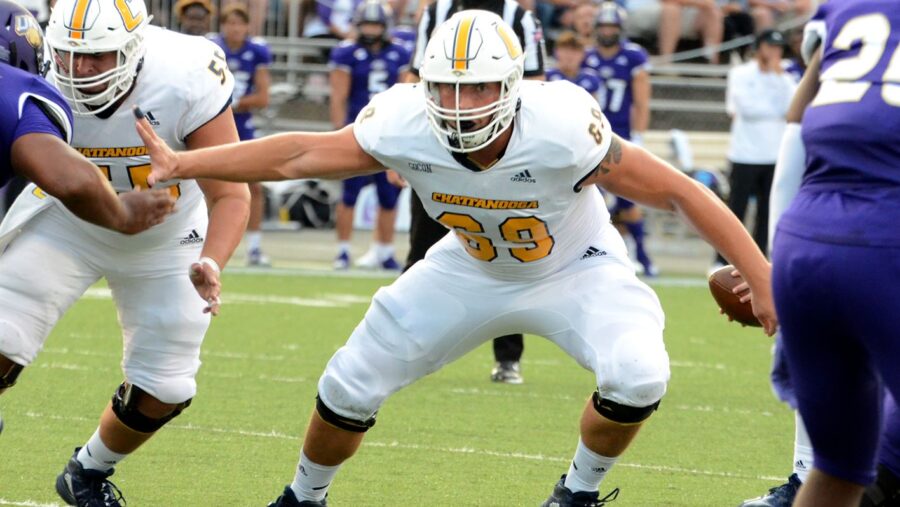
Height: 6’5”. Weight: 307 lbs. Arms: 33”.
Pros: A common qualifier applied to the majority of small school prospects factors around level of competition faced. Between his performance against Kentucky in the 2021 regular season and the recent Senior Bowl, Strange has eased most of those concerns in emphatic fashion. The All-Star event in Mobile had some ups and downs but overall, the Mocs interior lineman impressed, not least with his competitiveness and motor throughout. Primarily a guard in college, Strange showcased his potential versatility with his work at center at the Senior Bowl.
Meanwhile, Strange’s dominance against the Wildcats was among the better single-game performances from a prospect in this class. Facing some physically imposing SEC talent up front on the Kentucky D-line, Strange not only held up but excelled in his execution and work at the point of attack. The 6th-year interior offensive lineman was a significant part of the Mocs threatening an upset for much of the early-season non-con encounter.
The wider scope of his overall film archive is no less impressive. Despite potentially room for additional bulk to his frame, Strange’s strength stands out. That was backed up by 31 bench reps at the Combine, the tied-2nd highest mark by an OL this year. Also utilizing good arm length, he routinely holds his ground when challenged by the bull rush. More often, Strange is creating backward movement himself as he raises anchors and drives back opponents to open running lanes. The small-school lineman consistently takes the initiative out of his stance, attacking into the opening exchanges at the point-of-attack.
With fantastic movement, Strange is explosive and light on his feet, resulting in highlight-worthy lead blocks as a pulling guard. With a mauler mentality and nasty on-field demeanor, the film is littered with scattered opposition finished to the turf, or nowhere to be seen having been driven out of view. When unattached, the eyes are working to seek out a target to pancake.
The unrelenting aggression rarely comes at a cost, either. In pass protection, Strange typically sets an effective wide, sturdy base. With control and balance, he maintains form and leverage as he sustains blocks. The quick movement and agility allow him to adjust, recover and reset his feet when handling counters and blitz pickups. Finally, it’s worth noting that Strange has been All-Conference academically each season in college. By all accounts, the work ethic and drive are also fully present to take coaching and excel.
Cons: Though generally in control despite the aggressive mindset, there are moments where his form drops. Post-contact, he can lift his pad level and lose some coordination as he works to sustain blocks. He can slip off contact at times, but infrequently so. The vast majority of reps, Strange sets an stout base with effective leverage. His athleticism compensates at the FCS level, but he could be late out of his stance on occasions.
As referenced, there’s potential room for the Chattanooga lineman to gain additional bulk and muscle. His strength is good but there are examples of getting knocked back in the opening phase of reps by a strong punch or bull rush. At the Senior Bowl, there were some tougher snaps between the better moments. During 1-on-1 drills, Strange saw his share of loses when facing some higher level talent in attendance. In fairness to the small school standout, he was working from center at the All-Star event. While he has previous experience at the pivot position, he primarily worked at guard during college.
Wrapping Up: The former 2-star 250lb defensive end recruit out of high school has developed into an ascending O-line prospect. The movement skills, length and strength combine with a hot motor and mauler mentality. He could project to start early, yet still has elements of a developmental prospect that creates a promising eventual ceiling. Offering the utility to line up across the interior of the offensive line adds to his value. Chattanooga have gone five years without a draft pick; barring anything unexpected, that ends in 2022. His successful pre-draft process has given him a strong chance of landing as a Day 2 selection.
5. Braxton Jones, Offensive Tackle, Southern Utah. Grade: 74 (3rd Round)
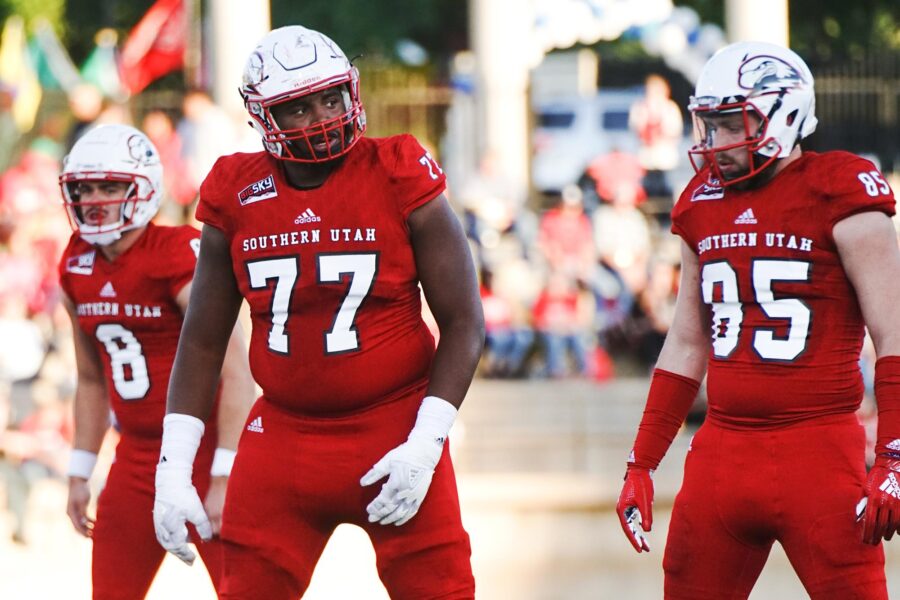
Height: 6’6”. Weight: 307 lbs. Arm: 35” 3/8.
Pros: Jones stands out from the first snap of the first game film as being built different from those around him. His unmissable presence on the Thunderbirds’ offensive line led to invites to both the Senior Bowl and Scouting Combine. Though playing primarily at a lower level, Southern Utah’s schedule allowed for additional opportunities to showcase himself against better competition prior to this pre-draft process. Jones faced off with back-to-back FBS opponents in San Jose State and Arizona State to open the season.
The physical measurables provide intriguing developmental potential to work with. Jones features a broad frame and outstanding length with over 35” arms. Big hands provide a powerful punch at the point of attack. Consistently dominating FCS opponents, Jones has imposing strength to overwhelm defenders in his way. The small school lineman moves quicker than expected in straight-line situations. Running under five seconds in the dash at the Combine attested to that. Measuring in at 307 lbs in Indianapolis, it would not surprise if he played slightly heavier during the season.
While some of the regular season film, including the top division matchups, had its flaws, Jones had a stronger Senior Bowl week than expected. Already tough and competitively driven, the improvements reported from practices in Mobile are encouraging and reflective of an ascending prospect with appealing upside. In addition to his nasty mauling play style, Jones shows positive movement traits. There are more explosive tackles, but Jones displays effective lateral mobility. That combines nicely with his extension to hold up to quickness off the edge.
When the extension and hand placement are on point, the results can be emphatic. Jones is capable of establishing control in the opening phase and to dictate movement. His initial setup is aided by swift release from his stance off the snap. His best reps feature good coordination between his base and upper body with footwork in-sync. In the run game, he makes for an intimidating figure on the second level seeking out blocks. The appeal is obvious.
Cons: Inconsistency in execution is a factor throughout the majority of Jones’ film in-season film. Though he has the extension to take the initiative in opening exchanges, he is occasionally late with his hands, off target, or both. His anchor and balance can be suboptimal to reduce the impact of his strength and length. Too often he allows D-linemen to work his chest and rock him back, despite his bulk and frame. When put in challenging positions early, the feet can become choppy and contribute to loss of form.
Jones was beaten a number of times in pass protection on film, including in his FBS matchups. Often, the issue centered around reacting late to inside counters and adjusting to second phase changeups. He can struggle at times to sustain blocks against fast-handed defenders. Polished pass rushers can work off Jones at the point and disengage. Capable of becoming too upright with ineffective pad level, he can allow outside rushers to win low and turn the corner. In run blocking, Jones’ momentum can work against him and glance off partial blocks ineffectively.
Wrapping Up: Jones was reportedly asked about the potential of transferring up to the FBS level for his final college season. That wasn’t under consideration, however. The Thunderbirds standout spoke to his loyalty for the team that gave him his chance. There is a lot to like about both his on-field and off-field mindset and work ethic. There is undeniable upside with Jones that could see him drafted earlier than expected, despite the inconsistency and the technique requiring cleaning up. The bulky frame, length, core strength and solid movement at his size provide a physical foundation to build on. A landing spot on Day 2 would not be a surprise. In terms of grading here, he sits as a high-reward 3rd round prospect.
6. Joshua Williams, Cornerback, Fayetteville State. Grade: 72 (3rd Round)
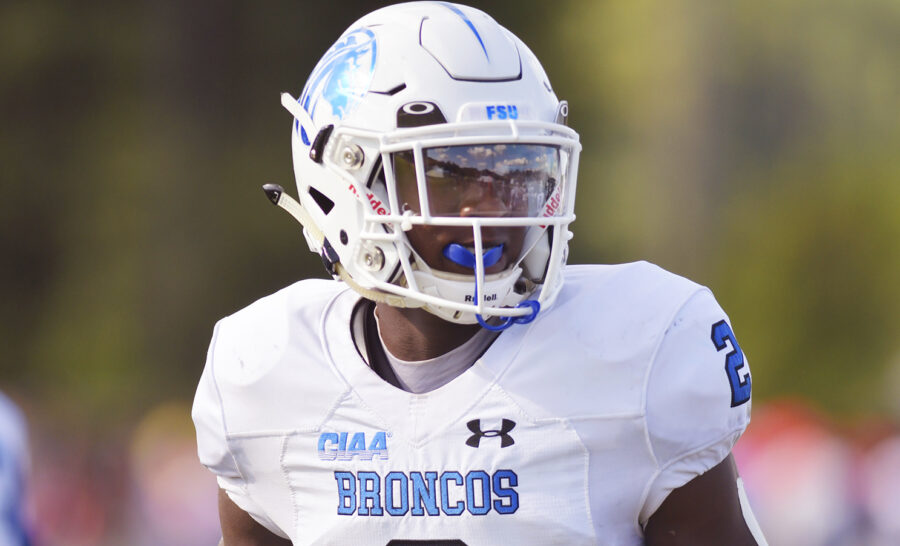
Height: 6’3”. Weight: 195 lbs. Arm: 32” 7/8. Hands: 9” 1/2.
Pros: The list of outstanding small school defensive back prospects extends beyond the FCS. There are at least four impressive Division 2 corners who can make pro rosters this coming season. Arguably leading the way is Fayetteville State’s Joshua Williams. The Broncos DB has steadily increased his wider notoriety through an unfaltering pre-draft process. Some praiseworthy practices at the Senior Bowl were followed by a rock-solid Combine workout. His work through the positional drills in the latter were particularly commendable.
Williams features an ideal frame with exceptional length. His nearly 6’3 height is complimented by almost 33” arms that surpasses plenty draftable offensive line prospects. His solidly proportioned and toned build has led to discussion of added versatility to contribute at safety, in addition to lining up outside. The D2 prospect boasts smooth movement as he covers ground. There’s an effortless polish as he navigates space and works in coverage.
At his good size, Williams shows quick foot speed as part of a fluid and efficient backpedal. The big-bodied defensive back was one of the more slick and controlled movers for his relative size while working through Combine positional drills. His minimal wasted motion and comfortable on-field operation results in rarely troubled film. Division 2 opposition infrequently threatened his leverage or challenged him vertically.
Though not tested often, Williams flashes nice ball skills. He routinely tracks the ball well and shows timing with his vertical. A former receiver, he may not have established himself on the offensive side of the ball, but elements of the usage at his former position show up in how he positions himself to challenge the ball in the air. Though his testing speed was modest, Williams arguably appears to play faster. That is not said in comparison to mostly limited D2 athletes but with recorded measurements working at the Senior Bowl.
Cons: Though the caveat was given above, Williams’ Combine dash time of 4.53 didn’t threaten the top end of the defensive back numbers in this class. It is being noted in the cons list here but truthfully isn’t a concern. Williams has a track background, plays fast, and does so with a larger, longer frame than much of this corner class. More of a concern regarding his lower body execution is in some responses to sharp receiver breaks, particularly comebacks. Williams can be a little slower in reacting and flat footed to allow the requisite separation for a comfortable completion.
That space allowance showed up a couple times during the game at the end of Senior Bowl week. There was a little bit of hesitancy and tentativeness during his snaps, particularly early on. Some conservative positioning led to separation conceded. It was a very encouraging week overall but there was certainly a share of ups-and-downs, not unsurprisingly. The significant step-up to the pros could lead to some time to adjust. He may need time as a prospect from D2 but also with being relatively new to the corner position overall.
Wrapping Up: Williams has a fairly raw game but all the desired developmental traits. He took well to the transition to the defensive side of the ball. In many ways, his film was reminiscent of another former D2 prospect in Pierre Desir out of Lindenwood in 2014. As with Williams, Desir had similar traits and movement with limitations in how much to take from the regular season film. The Senior Bowl event was a much greater indicator of Williams’ current standing. Though inconsistent in Mobile, there were plenty positives. Working in Williams’ favor, he has plenty experience on special teams units that ought to be useful while he works toward snaps in the defensive rotation.
7. Pierre Strong Jr, Running Back, South Dakota State. Grade: 67 (4th Round)
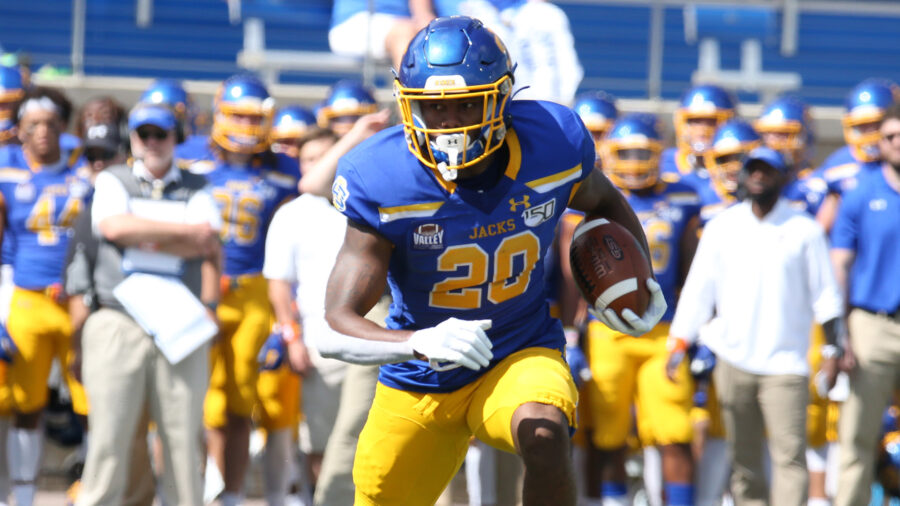
Height: 5’11”. Weight: 207 lbs. Arm: 31” 7/8.
Pros: Strong has been one of the more impressive runners in the FCS throughout his college career. The consistency, toughness, decision-making and production has warranted NFL consideration. He entered his final season firmly on the draft radar. Though perhaps an oversight at the time, Strong was personally previously noted as a good but potentially not elite athlete from his pre-2021 film. His performances as a redshirt senior, including the standout showing against FBS opposition in Colorado State, showcased Strong as unquestionably more explosive than anticipated.
In his single opportunity against a non-FCS defense this season, Strong excelled with 138 yards on just 13 carries (10.6 average) and two touchdowns against the Rams. In a career-best year, Strong totalled 1,686 rush yards and 18 TDs on the ground. He added 150 yards on 22 catches. Entering the pre-draft process generally considered a Day 3 pick, his outstanding Shrine Bowl and Combine performances has warranted discussion among many of the names near the upper tiers of the 2022 running back class.
While not the biggest back, Strong has consistently impressed with his work between the tackles. With a well-toned build for his frame, the Jackrabbits back plays bigger than his listed size, grinding out tough yardage through traffic. He wins in short areas through sharp footwork and excellent balance to work off contact and break through tackle attempts. Well-timed stiff arms often contribute toward extra gains as part of routinely maximizing available yardage on runs.
A reliable processor with excellent vision, he rarely misses an opportunity and can create when play structure breaks down. Once free, he has the quickness to exploit space and work on the second level. That speed was on display at the Scouting Combine, with Strong tied fastest among RBs with an eye-opening 4.37 dash (1.51 split).
A generally comfortable receiver and a competent pass protector, he checks off boxes as a well-rounded RB. While his receiving production has been somewhat modest, he has the potential to have a greater impact in this area as a pro than his college usage. His burst and top end speed will allow him to thrive in space and after the catch as a big-play threat.
Cons: There is some risk in projecting Strong’s role to the next level. Though far from undersized and with a physical tough approach, he might not continue his typical workload compiled with SDSU. Though he has looked sufficiently accomplished as a pass catcher, it has not been a significant portion of his touches in college. Conversely, it could be a larger part of his usage as a pro. Personally, the feeling is he will excel in most roles as a runner and receiver. There are occasional examples of dropped receiving opportunities that raise a little concern.
As a redshirt senior, Strong is a little older than a lot of running backs in this class. The position tends to see a larger portion of early entries and overall younger prospects than most positions. Strong’s relatively higher age might drop him slightly on some boards, depending on their cut-offs. The SDSU runner was somewhat fortunate to split time and carries with a talented teammate in then-sophomore Isaiah Davis. Despite this, Strong still has piled up a significant number of career touches over his time in college. He has not struggled with injuries but might be building some wear and tear with the accumulation of hits he has taken on a slightly smaller frame than some.
Wrapping Up: Strong checks some key boxes through his dominance at the FCS level, translatable speed and his smart, tough running style. Though not the biggest back, the former Jackrabbit is physical in his approach and in taking on contact. The potential to exploit defenses on the second and third level with his homerun hitting top speed should draw relatively early interest in adding Strong to a running back committee. He’s shown he can handle a heavy workload but might find more specified usage at the next level. Strong is not as extensively proven in his pass catching role, which will factor into projection uncertainty. However, if he can succeed in this area in the NFL, he can have an impactful pro career. Early Day 3 seems likely, but a late Day 2 selection may be possible with the right fit.
8. Zyon McCollum, Cornerback, Sam Houston State. Grade: 67 (4th Round)
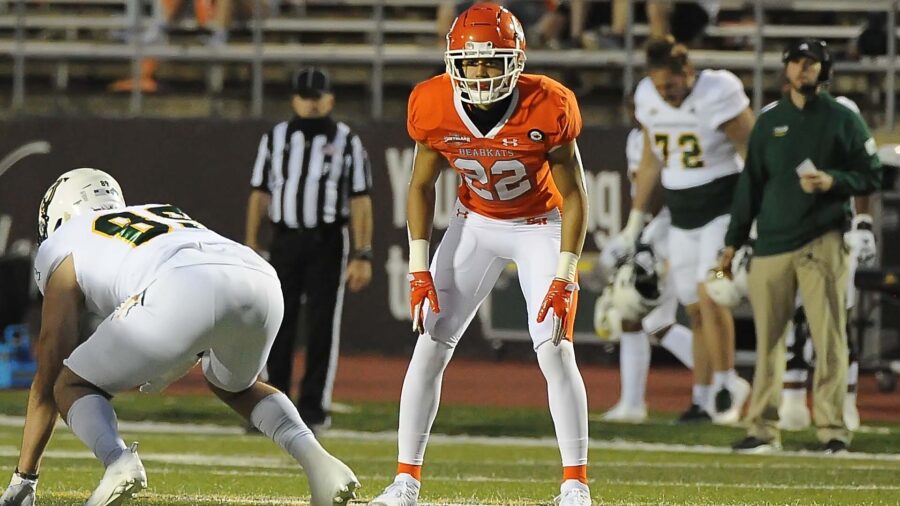
Height: 6’2”. Weight: 199 lbs. Arm: 30” 3/4. Hands: 9”.
Pros: There are many quantifiable metrics to buy into in order to justify an early round selection of Zyon McCollum. The size profile is appealing with a tall frame and good length. His Combine arm measurement came in at 30.75” but at 31” 1/8 at the Senior Bowl. Either way, he has adequate length to compete with taller receivers and as an outside corner. He is encouragingly well built also, with a muscular physique at around 200 lbs. While many longer corners are concerningly lean, McCollum has no such questions. Indeed, the potential consideration at safety is a possible option for added versatility and as a willing tackler.
Rounding out the physical traits, the Sam Houston DB was one of the most impressive performers at the Scouting Combine. Some exceptional testing from other defensive backs in Indy resulted in arguably subduing the notice McCollum’s showing deserved. At his frame, he shocked with a 4.33 dash (1.46 split), 39.5” vertical, 11’0 broad, 3.94 shuttle and a ridiculous 6.48 cone time. It will not be difficult for teams to justify taking a chance on a prospect with such a rare combination of measurables.
The numbers are also in his favor from a production standpoint. A dominant playmaker in the secondary, McCollum piled up passes defended as a reflection of his projectable ball skills. Over his five college seasons, he totalled 41 pass breakups and 13 career interceptions. His best numbers statistically came in his earlier years, but it would make sense for most coordinators and quarterbacks to start to look elsewhere with targets. He’s shown himself to be capable of utilizing his length well at the catch point. His solid build allows for holding strong for favorable positioning relative to the receiver.
The athletic numbers translate to his execution on film. Contrary to many longer-limbed corners, McCollum’s agility and fluidity shows up on his better reps. The loose hips and transitions to turn and run are joined by balance and good foot cadence to efficiently keep in phase in man coverage. The long strides factor into tracking deep targets, opening his hips well to turn and run, hitting top speed quickly. He’ll also use his arms well off press to make contact off the line.
The skill set demonstrated suggests McCollum will be capable of handling man and zone assignments, to work in press or off coverage. His closing speed and generally reliable reads and reactions will aid him when deployed in zone. There is impressive commitment to the physical elements of the game. The SHSU corner will throw his weight behind tackle attempts and can often wrap up well when in position.
Cons: The agility and fluidity shown at the Combine and often on film is frustratingly not there consistently. At times, he looks surprisingly more cumbersome and awkward in his footwork and short area changes of direction. Stiffness in his overall movements is present on a number of snaps. It’s uncertain as to whether this tightness is reflective of situation and tensing mentally, as he has clearly demonstrated that he has the natural fluidity wanted.
Inconsistency is also evident on film in his coverage. There are moments of losing contact at the top of routes, sacrificing a step as the receiver breaks and not always able to recover. Concentration lapses can see him drift and lose track of his assignment for some simple separation. Despite the ball production, he can give up a number of plays when targeted outside, including when in position. There are examples of poor timing of his jumps and hand extension at the catch point. He can take up suboptimal positions that can negate his physical advantages. During the 2021 playoffs, he was beaten concerningly easy on a number of receptions against Incarnate Word and in the loss to Montana State in the quarter finals.
Wrapping Up: When collating the size, obscene athletic testing and impressive statistical ball production, it’s no surprise that McCollum is considered a name climbing draft boards over the last couple months. Banking on those tangible metrics would be more than reasonable as a high-upside prospect. That said, his film on a snap-to-snap basis has concerns and inconsistency that requires maintaining perspective following his exciting pre-draft process. McCollum has some development to go. Much like the LA Rams’ Robert Rochell from the previous draft class though, there is a lot to work with, while contributing on special teams early as an option.
9. Decobie Durant, Cornerback, South Carolina State. Grade: 63 (4th Round)
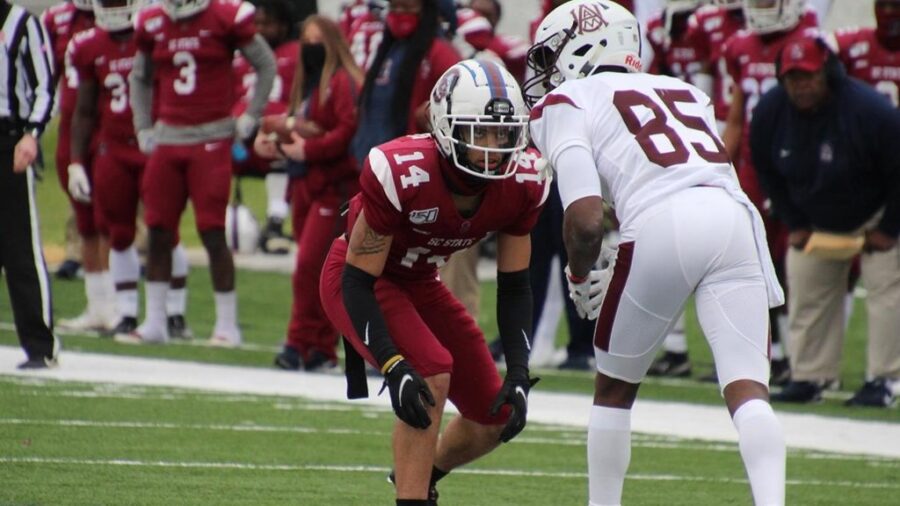
Height: 5’10”. Weight: 183 lbs. Arm: 30” 3/4. Hands: 8” 3/4.
Pros: Though size will of course have to be considered, there is so much to love about Durant’s game and abilities. Firstly, regarding the size, the Bulldogs corner is far from tiny at a shade under 5’10 and with close to 31” arms. He also plays up to his team’s mascot as an absolute bulldog on the field, playing bigger than his listed size would indicate. There is an energy and ferocity to his play style. As desired from a relatively smaller player at the position, Durant has the requisite burst and speed to help compensate for other limitations.
Those athletic measurables include running an outstanding 4.38 dash at the Scouting Combine. The argument could also be made that in a phenomenal defensive back group in attendance, Durant had one of the better positional field workouts among the DBs in Indy. Durant and Florida’s Kaiir Elam went back-to-back throughout the day, and it was fascinating to watch the two prospects with differing body types and draft stock putting on a show one after the other.
In addition to the Combine, Durant was reportedly outstanding at the Shrine Bowl practices. Durant also took full advantage of a superb opportunity to impress against Clemson early in the 2021 season. Looking the part among the top-level athletes on the Tigers offense, Durant stood out snap-to-snap in what likely has been the first game film used by most scouts. They ought to be unanimously impressed.
Durant had two interceptions and 2 breakups, the majority of which came against the starting Tigers offense. One of the breakups was close to being taken as a pick-six the other way. His outstanding instincts, anticipation and burst were on show to jump multiple routes as he aggressively attacked the ball. Speaking to the earlier comment of playing bigger, Durant made plays against physical opposition in matchups against Joseph Ngata. He is not to be discounted as a tackler either. The Bulldogs corner is capable in open-field situations, positioning well and committing with momentum to give him maximum opportunity to make the play, despite build limitations.
Throughout his coverage reps, Durant displays fantastic overall movement and agility. With a spring in his step, he has effortless movement in all directions and in his transitions. The foot quickness, backpedal, hips, changes of direction and all-round explosiveness are readily apparent. Add in his anticipation and awareness, he is consistently sticky in coverage, keeping in phase, including as receivers break their routes. The intelligence and instincts are obvious with his clever positioning and timing. Durant’s ball tracking and ball skills are polished and impactful. Despite smaller hands, the playmaker secures the ball like a receiver.
Cons: Much of the pros section is written in deserving defiance of concern over size and the manner in which he can compensate. Here though, there’s a need to include some objectivity to the alternative perspective. There are certain inevitable limitations relating to the relatively lesser length and size. Though playing big and aggressive, Durant does feature a slighter frame that will factor into some situations at the next level. Playing a mix of slot and outside corner with South Carolina State, it’s less likely that he’ll see much use outside in the NFL. He has all the traits though to be an effective slot, more-or-less a starting position in the pros now.
A little older than most prospects, it’s not ideal that Durant will begin as a 24-year-old rookie. However, if he sticks around as a good contributor for four years of a rookie contract as a Day 3 selection, is that really something to be overly concerned about? The energetic and fiery attitude mentioned is primarily a positive. That said, some penalties are present occasionally on film. Being wary of how he’s using his hands prior to the arrival of the ball is something to work on. His aggressive nature is very much a net-positive, however.
Wrapping Up: South Carolina State have produced several standout NFL players in recent years. Those names have included Javon Hargrave and Darius Leonard. Even though Durant may not reach the impact of someone such as Leonard, he has the potential to start in the pros. The FCS corner is explosive, intelligent, high-motor, tough and technically talented. As someone very bullish on Durant as a prospect, the opinion here is that wherever he is drafted, he could ultimately end up as a bargain, regardless.
10. Markquese Bell, Safety, Florida A&M. Grade: 59 (4th-5th Round)
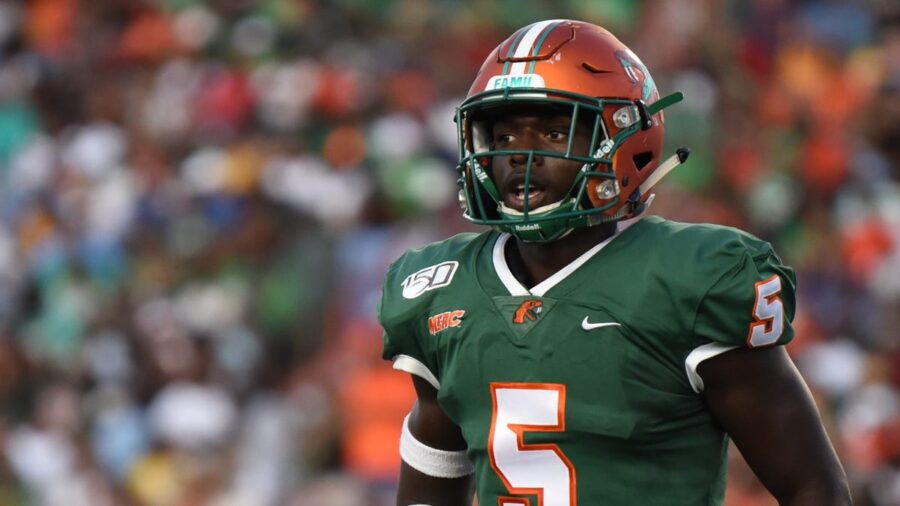
Height: 6’2”. Weight: 212 lbs. Arm: 33” 1/2.
Pros: There has been a much-welcomed concerted push for increased promotion and exposure for HBCU football recently. Coveted draft prospects can only help that cause, with several potentially set to be selected in the 2022 class. Florida A&M safety Markquese Bell is one of the more enticing candidates as part of a strong small school secondary group for the upcoming NFL Draft. Bell closed out a productive final season that included 95 tackles for the Rattlers. That included 6.5 tackles for loss, 2 sacks, 1 breakup, 1 interception and 5 forced fumbles.
While the 2021 season didn’t include notable ball production, his previous tally in 2019 of 9 pass breakups and 5 interceptions is more encouraging on that front, from a purely statistical perspective. While playing at a lower competition level, Bell had an impactful performance against FBS opposition in South Florida this year. The Rattlers safety piled up 15 stops and a sack against the Bulls.
One of the most physically intimidating safeties in this class, Bell ticks the boxes in terms of measurables with ideal length, size, speed and power. That was confirmed definitively at the Scouting Combine, including a 4.41 dash (1.51 split), 36.5” vertical and 10’3 broad jump. Such athletic potential didn’t go unnoticed out of high school, however. The football and track & field standout was a coveted 4-star recruit who initially joined Maryland. A suspension for unannounced reasons led to a season at Coffeyville Community College in Kansas before re-emerging with Florida A&M in 2019.
An imposing safety prospect, Bell is arguably at his best as a downhill wrecking ball. Bringing an alpha demeanor, the HBCU star hits emphatically as a violent presence. The intention appears to always make ball carriers regret entering his field of influence, and reconsider doing so in the future. He brings the same authority at the catch point to fight for the football. Bell also offers the speed to provide range in coverage.
An issue for many when working downhill, Bell is better than most at forcing his path to the ball carrier. The Rattlers defender fights through traffic well, able to take on and work off contact to take more direct routes to the action. The straight-line closing speed is a factor in some explosive highlight hits. There’s no question that he is currently superior against the run that versus the pass. However, he shows positives at the catch point with positioning and timing, attacking the ball and able to secure an interception with better hands than many on the defensive side of the ball.
Cons: Limitations in coverage show up at times beyond the catch point. He’ll be at his best against the pass with the action in front and in providing support over the top. When left in space 1-on-1 and when working in close man coverage, Bell can struggle to stay in position. He can be late reacting to moves and unable to recover from conceded steps. Though fast going forward, there’s some more tightness in working backward in short area changes of direction and overall lateral mobility.
As impactful as the aggressive tackling can be, the big hits are interspersed with missed opportunities from poor technique. Launching with momentum can result in glancing blows, and the lack of more consistent wrap-up technique could be costly. The fervor for flying forward can further impact through abandoning space behind. The FAMU safety’s overall reads, positioning and initial movements can sharpen. Discipline in responsibility while maintaining his physical presence will be a positive balance to aim to achieve.
Wrapping Up: From recruitment out of high school to this point, the tools and traits have been there for Bell, even if the path deviated from the original plan. Bell offers a favorable blend of size, length, speed and physicality. There are elements of coverage to clean up, but positives shown with his ball skills. At his best against the run, he can be a force working downhill from deep. Bell could prove an asset on special teams early while working his way into the defensive rotation.
Feature Image Credit: Tim Sanger

